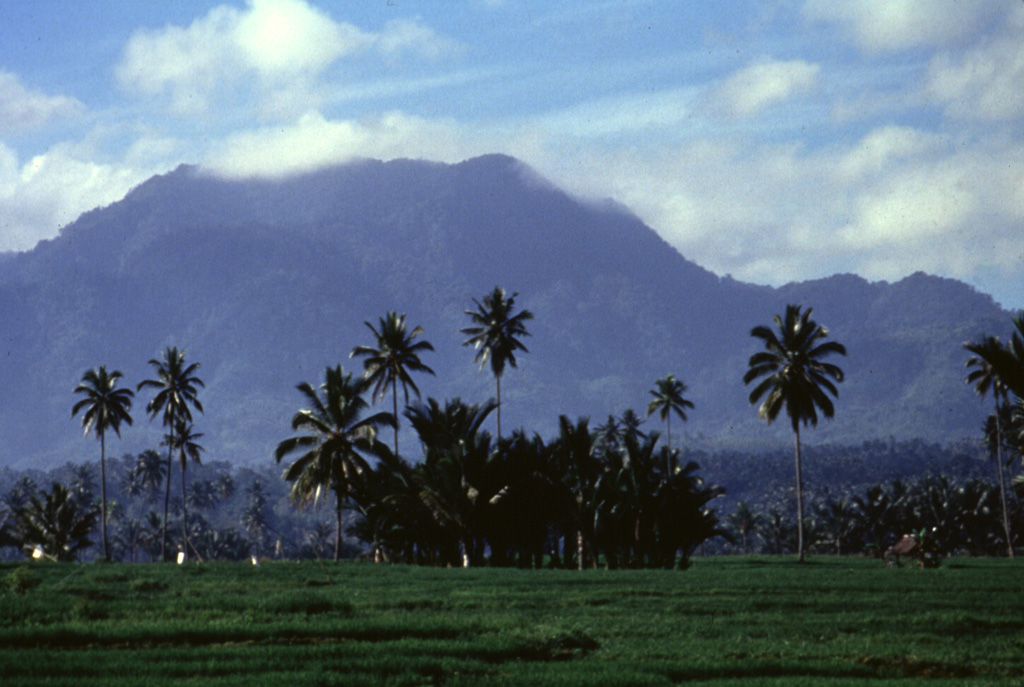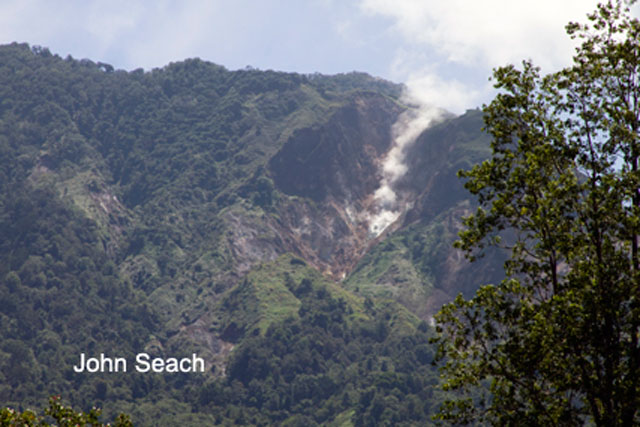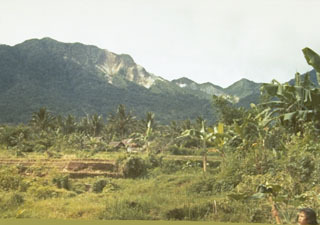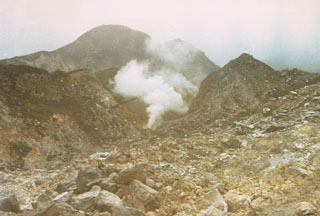

PVMBG noted that due to decreased volcanic seismicity and activity the Alert Level for Ambang was lowered to 1 (on a scale of 1-4) on 8 August. Residents and visitors were advised to not approach the crater.
Source: Pusat Vulkanologi dan Mitigasi Bencana Geologi (PVMBG, also known as CVGHM)
1966 to August 2014; sporadic eruptions and seismicity
This Bulletin report, our first one on Ambang (figure 1), covers activity from 1966 to August 2014. Activity was sporadic, with decades of neither eruptions nor significant seismicity. Data for this report was gathered primarily from the Pusat Vulkanologi dan Mitigasi Bencana Geologi (PVMBG; here referenced as CVGHM which stands for Center for Volcanology and Geological Hazard Mitigation) and the Darwin Volcanic Ash Advisory Centre (VAAC).
1966 to 2013. In 1966, earthquakes were felt as far away as Purworejo (figure 1). These were followed closely by the release of sulfurous gases through two new vents near Kali Putih E and on the N slopes of Ambang's crater.
On 22 December 2005, Ambang erupted phreatically, forming a fumarolic field that was still in existence during 2014.
According to CVGHM (2014), resulting pyroclastic flows from potential magmatic eruptions were most likely at that time to affect villages to the SE, including settlements such as Bongkudai, Goaan, Purworejo, and Modayong.
Ambang's seismic activity for this reporting interval was generally mild and the hazard status mostly remained low (Level I). In 2010, seismicity substantially increased with a maximum of 33 earthquakes (during unstated interval) and the Alert Level was raised to II (on a scale of I-IV).
In June 2013, there were two active fumaroles on the SW side of Ambang, based on an expedition by John Seach that was reported on VolcanoLive. The westernmost fumarole emitted a thin white plume to ~100 m above the vent and the easternmost fumarole occasionally emitted short white vapor (figure 2). Furthermore, the team noted that the summit was "heavily forested" and there was "a strong smell of sulfur."
 |
Figure 2. A fumarole on Ambang released a plume to several meters high. More pictures of Seach's visit are listed on the VolcanoLive website. Photograph by John Seach. Courtesy of VolcanoLive. |
Activity during 2014. From June to August 2014, Ambang had a short-lived substantial increase in volcanic seismicity and a more constant tectonic seismicity (table 1). On 3 July 2014, CVGHM raised the alert level from Normal (I) to Alert (II), and the region within 1.5 km of the crater was cordoned off. Thin, gas emissions were observed rising throughout June, July, and August from the crater to a height of 10-25 m. By 8 August, the volcanic seismicity decreased and CVGHM lowered the alert level from II to I. The Aviation Color Code also changed from Yellow to Green, based on a Darwin VAAC report. However, residents were still cautioned not to approach the crater.
Table 1. Number of earthquakes between June and August 2014 as recorded by analog and digital CVGHM seismographs at Ambang. (Exact location of seismographs unspecified.) Volcanic (Volc.) earthquakes are categorized based on their depths as shallow or deep; and the tectonic (tect.) earthquakes, based on their distances from Ambang as local or distant. Note that CVGHM did not quantify "shallow," "deep," "local," and "distant." The time intervals are of irregular length. Data courtesy of CVGHM.
| Date | Shallow (volc) | Deep (volc.) | Local (tect.) | Distant (tect.) |
| 01 Jun-08 Jun 2014 | 8 | 7 | 1 | 31 |
| 09 Jun-16 Jun 2014 | 7 | 2 | 1 | 34 |
| 17 Jun-24 Jun 2014 | 8 | 9 | 1 | 35 |
| 25 Jun-02 Jul 2014 | 9 | 6 | 0 | 29 |
| 03 Jul 2014 | 33 | 29 | 0 | 0 |
| 01 Jul-10 Jul 2014 | 58 | 45 | 2 | 41 |
| 11 Jul-19 Jul 2014 | 92 | 30 | 1 | 38 |
| 20 Jul-28 Jul 2014 | 123 | 39 | 1 | 38 |
| 29 Jul-06 Aug 2014 | 28 | 9 | 0 | 43 |
CVGHM background. The Ambang stratovolcano consists of a row of relatively-young cones from the Quaternary period, which extend N and S. It lies in an area cut by normal faults. Ambang's generally has had repose intervals of 39 to 127 years between eruptions.
CVGHM also noted that previous eruptions were often dominated by lava flows, pyroclastic flows, and ashfall.
As seen on figure 3, the regions affected by eruptions at Ambang have been qualified by Hadisantono and others (2007) into hazard zones I (yellow), II (light pink), and III (darker pink). Each of these areas is defined by both a radial area with circles, as well as specific irregularly shaped zones corresponding to topography or local conditions. The key is in both Indonesian and English (legible on the pdf version).
According to CVGHM (2014), the population densities for hazard zones I and II have increased dramatically in the past decades. They noted 17,240 people in hazard zone II alone as of 2014.
Geochemistry tables for Ambang appear in CVGHM (2014) and in Jaffe and others (2004).
References. Hadisantono, R.D.; Haerani, N.; Martono, A.; Pujowarsito; Purwoto; 2007; Peta Kawasan Rawan Bencana Gunungapi Ambang Provinsi Sulawesi Utari; Pusat Vulkanologi Dan Mitigase Bencana Geologi Departemen Energi Dan Sumber Daya Mineral, Featured in CVGHM (2014) (URL: http://www.vsi.esdm.go.id/index.php/gunungapi/data-dasar-gunungapi/481-g-ambang?start=6) [accessed in March 2015]
Jaffe, L. A.; Hilton, D. R.; Fischer, T. P.; Hartono, U; 2004; Tracing magma sources in an arc-arc collision zone: Helium and carbon isotope and relative abundance systematics of the Sangihe Arc, Indonesia. (URL: http://onlinelibrary.wiley.com/doi/10.1029/2003GC000660/abstract)
CVGHM [Pusat Vulkanologi dan Mitigasi Bencana Geologi]; (28 May) 2014; 6.2 G. Ambang Sulawesi Utari; [Published as pdf in Indonesian, with occasional English and containing the Hadisantono and others (2007) hazard map], 10 pages (URL: http://www.vsi.esdm.go.id/index.php/gunungapi/data-dasar-gunungapi/481-g-ambang) [accessed in March 2015]
VolcanoLive; 2014; Ambang Volcano – John Seach (URL: http://www.volcanolive.com/ambang.html) [accessed March 2015]
Information Contacts: Center for Volcanology and Geological Hazard Mitigation (CVGHM, Pusat Vulkanologi dan Mitigasi Bencana Geologi), Badan Geologi, Kementerian Energi dan Sumber Daya Mineral (ESDM), Yogyakarta 55166, Indonesia (URL: http://www.vsi.esdm.go.id/); Darwin Volcanic Ash Advisory Centre (VAAC) (URL: http://www.bom.gov.au/info/vaac/).
PVMBG noted that due to decreased volcanic seismicity and activity the Alert Level for Ambang was lowered to 1 (on a scale of 1-4) on 8 August. Residents and visitors were advised to not approach the crater.
Source: Pusat Vulkanologi dan Mitigasi Bencana Geologi (PVMBG, also known as CVGHM)
On 3 July, CVGHM reported a significant increase in seismicity from Ambang, particularly shallow earthquakes (VB). During 1 June-2 July, 7-9 shallow volcanic (VB) and 2-9 deep volcanic (VA) earthquakes were detected per week, for totals of 33 VB and 29 VA earthquakes in that time. The Alert Level was raised to Level 2 on 3 July. An exclusion zone was placed around the crater with a radius of 1.5 km. Persistent diffuse gas emissions were observed reaching 10-25 m above the crater.
CVGHM noted that previous eruptions were dominated by effusive lava flows and were punctuated by explosive eruptions producing pyroclastic flows and fallout. The last event recorded at Ambang was a phreatic explosion in 2005; a persistent fumarolic field remains from that activity. CVGHM noted that a magmatic eruption generating pyroclastic flows would threaten communities SE of the summit including the villages of Bongkudai, Goaan, Purworejo, and Modayong.
Source: Pusat Vulkanologi dan Mitigasi Bencana Geologi (PVMBG, also known as CVGHM)
Reports are organized chronologically and indexed below by Month/Year (Publication Volume:Number), and include a one-line summary. Click on the index link or scroll down to read the reports.
1966 to August 2014; sporadic eruptions and seismicity
This Bulletin report, our first one on Ambang (figure 1), covers activity from 1966 to August 2014. Activity was sporadic, with decades of neither eruptions nor significant seismicity. Data for this report was gathered primarily from the Pusat Vulkanologi dan Mitigasi Bencana Geologi (PVMBG; here referenced as CVGHM which stands for Center for Volcanology and Geological Hazard Mitigation) and the Darwin Volcanic Ash Advisory Centre (VAAC).
1966 to 2013. In 1966, earthquakes were felt as far away as Purworejo (figure 1). These were followed closely by the release of sulfurous gases through two new vents near Kali Putih E and on the N slopes of Ambang's crater.
On 22 December 2005, Ambang erupted phreatically, forming a fumarolic field that was still in existence during 2014.
According to CVGHM (2014), resulting pyroclastic flows from potential magmatic eruptions were most likely at that time to affect villages to the SE, including settlements such as Bongkudai, Goaan, Purworejo, and Modayong.
Ambang's seismic activity for this reporting interval was generally mild and the hazard status mostly remained low (Level I). In 2010, seismicity substantially increased with a maximum of 33 earthquakes (during unstated interval) and the Alert Level was raised to II (on a scale of I-IV).
In June 2013, there were two active fumaroles on the SW side of Ambang, based on an expedition by John Seach that was reported on VolcanoLive. The westernmost fumarole emitted a thin white plume to ~100 m above the vent and the easternmost fumarole occasionally emitted short white vapor (figure 2). Furthermore, the team noted that the summit was "heavily forested" and there was "a strong smell of sulfur."
 |
Figure 2. A fumarole on Ambang released a plume to several meters high. More pictures of Seach's visit are listed on the VolcanoLive website. Photograph by John Seach. Courtesy of VolcanoLive. |
Activity during 2014. From June to August 2014, Ambang had a short-lived substantial increase in volcanic seismicity and a more constant tectonic seismicity (table 1). On 3 July 2014, CVGHM raised the alert level from Normal (I) to Alert (II), and the region within 1.5 km of the crater was cordoned off. Thin, gas emissions were observed rising throughout June, July, and August from the crater to a height of 10-25 m. By 8 August, the volcanic seismicity decreased and CVGHM lowered the alert level from II to I. The Aviation Color Code also changed from Yellow to Green, based on a Darwin VAAC report. However, residents were still cautioned not to approach the crater.
Table 1. Number of earthquakes between June and August 2014 as recorded by analog and digital CVGHM seismographs at Ambang. (Exact location of seismographs unspecified.) Volcanic (Volc.) earthquakes are categorized based on their depths as shallow or deep; and the tectonic (tect.) earthquakes, based on their distances from Ambang as local or distant. Note that CVGHM did not quantify "shallow," "deep," "local," and "distant." The time intervals are of irregular length. Data courtesy of CVGHM.
| Date | Shallow (volc) | Deep (volc.) | Local (tect.) | Distant (tect.) |
| 01 Jun-08 Jun 2014 | 8 | 7 | 1 | 31 |
| 09 Jun-16 Jun 2014 | 7 | 2 | 1 | 34 |
| 17 Jun-24 Jun 2014 | 8 | 9 | 1 | 35 |
| 25 Jun-02 Jul 2014 | 9 | 6 | 0 | 29 |
| 03 Jul 2014 | 33 | 29 | 0 | 0 |
| 01 Jul-10 Jul 2014 | 58 | 45 | 2 | 41 |
| 11 Jul-19 Jul 2014 | 92 | 30 | 1 | 38 |
| 20 Jul-28 Jul 2014 | 123 | 39 | 1 | 38 |
| 29 Jul-06 Aug 2014 | 28 | 9 | 0 | 43 |
CVGHM background. The Ambang stratovolcano consists of a row of relatively-young cones from the Quaternary period, which extend N and S. It lies in an area cut by normal faults. Ambang's generally has had repose intervals of 39 to 127 years between eruptions.
CVGHM also noted that previous eruptions were often dominated by lava flows, pyroclastic flows, and ashfall.
As seen on figure 3, the regions affected by eruptions at Ambang have been qualified by Hadisantono and others (2007) into hazard zones I (yellow), II (light pink), and III (darker pink). Each of these areas is defined by both a radial area with circles, as well as specific irregularly shaped zones corresponding to topography or local conditions. The key is in both Indonesian and English (legible on the pdf version).
According to CVGHM (2014), the population densities for hazard zones I and II have increased dramatically in the past decades. They noted 17,240 people in hazard zone II alone as of 2014.
Geochemistry tables for Ambang appear in CVGHM (2014) and in Jaffe and others (2004).
References. Hadisantono, R.D.; Haerani, N.; Martono, A.; Pujowarsito; Purwoto; 2007; Peta Kawasan Rawan Bencana Gunungapi Ambang Provinsi Sulawesi Utari; Pusat Vulkanologi Dan Mitigase Bencana Geologi Departemen Energi Dan Sumber Daya Mineral, Featured in CVGHM (2014) (URL: http://www.vsi.esdm.go.id/index.php/gunungapi/data-dasar-gunungapi/481-g-ambang?start=6) [accessed in March 2015]
Jaffe, L. A.; Hilton, D. R.; Fischer, T. P.; Hartono, U; 2004; Tracing magma sources in an arc-arc collision zone: Helium and carbon isotope and relative abundance systematics of the Sangihe Arc, Indonesia. (URL: http://onlinelibrary.wiley.com/doi/10.1029/2003GC000660/abstract)
CVGHM [Pusat Vulkanologi dan Mitigasi Bencana Geologi]; (28 May) 2014; 6.2 G. Ambang Sulawesi Utari; [Published as pdf in Indonesian, with occasional English and containing the Hadisantono and others (2007) hazard map], 10 pages (URL: http://www.vsi.esdm.go.id/index.php/gunungapi/data-dasar-gunungapi/481-g-ambang) [accessed in March 2015]
VolcanoLive; 2014; Ambang Volcano – John Seach (URL: http://www.volcanolive.com/ambang.html) [accessed March 2015]
Information Contacts: Center for Volcanology and Geological Hazard Mitigation (CVGHM, Pusat Vulkanologi dan Mitigasi Bencana Geologi), Badan Geologi, Kementerian Energi dan Sumber Daya Mineral (ESDM), Yogyakarta 55166, Indonesia (URL: http://www.vsi.esdm.go.id/); Darwin Volcanic Ash Advisory Centre (VAAC) (URL: http://www.bom.gov.au/info/vaac/).
|
|
||||||||||||||||||||||||||
There is data available for 2 confirmed eruptive periods.
2005 Dec 22 Confirmed Eruption (Explosive / Effusive) VEI: 1
| Episode 1 | Eruption (Explosive / Effusive) | ||||||||||||||||||||||||
|---|---|---|---|---|---|---|---|---|---|---|---|---|---|---|---|---|---|---|---|---|---|---|---|---|
| 2005 Dec 22 - Unknown | Evidence from Observations: Reported | |||||||||||||||||||||||
|
List of 3 Events for Episode 1
|
||||||||||||||||||||||||
1845 ± 5 years Confirmed Eruption (Explosive / Effusive)
| Episode 1 | Eruption (Explosive / Effusive) | ||||
|---|---|---|---|---|
| 1845 ± 5 years - Unknown | Evidence from Observations: Reported | |||
This compilation of synonyms and subsidiary features may not be comprehensive. Features are organized into four major categories: Cones, Craters, Domes, and Thermal Features. Synonyms of features appear indented below the primary name. In some cases additional feature type, elevation, or location details are provided.
Cones |
||||
| Feature Name | Feature Type | Elevation | Latitude | Longitude |
| Binangunan, Mount | Stratovolcano | 1795 m | ||
 The compound volcano Ambang, seen here from Purworejo village, is the westernmost of the active volcanoes on the northern arm of Sulawesi Island. Five fumarole fields are located near the summit. An eruption in the 1840's is the only one known from Ambang volcano.
The compound volcano Ambang, seen here from Purworejo village, is the westernmost of the active volcanoes on the northern arm of Sulawesi Island. Five fumarole fields are located near the summit. An eruption in the 1840's is the only one known from Ambang volcano. This fumarole, located on the SE side of the summit, is the largest in the five solfatara fields at the summit of Ambang volcano.
This fumarole, located on the SE side of the summit, is the largest in the five solfatara fields at the summit of Ambang volcano. Ambang volcano, towering above farmlands below its western flank, is a large stratovolcano at the western end of a volcanic chain stretching across the northern arm of the island of Sulawesi. The only recorded historical eruption took place during the 1840's. Five solfatara fields occur at the summit of Gunung Ambang.
Ambang volcano, towering above farmlands below its western flank, is a large stratovolcano at the western end of a volcanic chain stretching across the northern arm of the island of Sulawesi. The only recorded historical eruption took place during the 1840's. Five solfatara fields occur at the summit of Gunung Ambang.There are no samples for Ambang in the Smithsonian's NMNH Department of Mineral Sciences Rock and Ore collection.
| Copernicus Browser | The Copernicus Browser replaced the Sentinel Hub Playground browser in 2023, to provide access to Earth observation archives from the Copernicus Data Space Ecosystem, the main distribution platform for data from the EU Copernicus missions. |
| MIROVA | Middle InfraRed Observation of Volcanic Activity (MIROVA) is a near real time volcanic hot-spot detection system based on the analysis of MODIS (Moderate Resolution Imaging Spectroradiometer) data. In particular, MIROVA uses the Middle InfraRed Radiation (MIR), measured over target volcanoes, in order to detect, locate and measure the heat radiation sourced from volcanic activity. |
| MODVOLC Thermal Alerts | Using infrared satellite Moderate Resolution Imaging Spectroradiometer (MODIS) data, scientists at the Hawai'i Institute of Geophysics and Planetology, University of Hawai'i, developed an automated system called MODVOLC to map thermal hot-spots in near real time. For each MODIS image, the algorithm automatically scans each 1 km pixel within it to check for high-temperature hot-spots. When one is found the date, time, location, and intensity are recorded. MODIS looks at every square km of the Earth every 48 hours, once during the day and once during the night, and the presence of two MODIS sensors in space allows at least four hot-spot observations every two days. Each day updated global maps are compiled to display the locations of all hot spots detected in the previous 24 hours. There is a drop-down list with volcano names which allow users to 'zoom-in' and examine the distribution of hot-spots at a variety of spatial scales. |
|
WOVOdat
Single Volcano View Temporal Evolution of Unrest Side by Side Volcanoes |
WOVOdat is a database of volcanic unrest; instrumentally and visually recorded changes in seismicity, ground deformation, gas emission, and other parameters from their normal baselines. It is sponsored by the World Organization of Volcano Observatories (WOVO) and presently hosted at the Earth Observatory of Singapore.
GVMID Data on Volcano Monitoring Infrastructure The Global Volcano Monitoring Infrastructure Database GVMID, is aimed at documenting and improving capabilities of volcano monitoring from the ground and space. GVMID should provide a snapshot and baseline view of the techniques and instrumentation that are in place at various volcanoes, which can be use by volcano observatories as reference to setup new monitoring system or improving networks at a specific volcano. These data will allow identification of what monitoring gaps exist, which can be then targeted by remote sensing infrastructure and future instrument deployments. |
| Volcanic Hazard Maps | The IAVCEI Commission on Volcanic Hazards and Risk has a Volcanic Hazard Maps database designed to serve as a resource for hazard mappers (or other interested parties) to explore how common issues in hazard map development have been addressed at different volcanoes, in different countries, for different hazards, and for different intended audiences. In addition to the comprehensive, searchable Volcanic Hazard Maps Database, this website contains information about diversity of volcanic hazard maps, illustrated using examples from the database. This site is for educational purposes related to volcanic hazard maps. Hazard maps found on this website should not be used for emergency purposes. For the most recent, official hazard map for a particular volcano, please seek out the proper institutional authorities on the matter. |
| IRIS seismic stations/networks | Incorporated Research Institutions for Seismology (IRIS) Data Services map showing the location of seismic stations from all available networks (permanent or temporary) within a radius of 0.18° (about 20 km at mid-latitudes) from the given location of Ambang. Users can customize a variety of filters and options in the left panel. Note that if there are no stations are known the map will default to show the entire world with a "No data matched request" error notice. |
| UNAVCO GPS/GNSS stations | Geodetic Data Services map from UNAVCO showing the location of GPS/GNSS stations from all available networks (permanent or temporary) within a radius of 20 km from the given location of Ambang. Users can customize the data search based on station or network names, location, and time window. Requires Adobe Flash Player. |
| DECADE Data | The DECADE portal, still in the developmental stage, serves as an example of the proposed interoperability between The Smithsonian Institution's Global Volcanism Program, the Mapping Gas Emissions (MaGa) Database, and the EarthChem Geochemical Portal. The Deep Earth Carbon Degassing (DECADE) initiative seeks to use new and established technologies to determine accurate global fluxes of volcanic CO2 to the atmosphere, but installing CO2 monitoring networks on 20 of the world's 150 most actively degassing volcanoes. The group uses related laboratory-based studies (direct gas sampling and analysis, melt inclusions) to provide new data for direct degassing of deep earth carbon to the atmosphere. |
| Large Eruptions of Ambang | Information about large Quaternary eruptions (VEI >= 4) is cataloged in the Large Magnitude Explosive Volcanic Eruptions (LaMEVE) database of the Volcano Global Risk Identification and Analysis Project (VOGRIPA). |
| EarthChem | EarthChem develops and maintains databases, software, and services that support the preservation, discovery, access and analysis of geochemical data, and facilitate their integration with the broad array of other available earth science parameters. EarthChem is operated by a joint team of disciplinary scientists, data scientists, data managers and information technology developers who are part of the NSF-funded data facility Integrated Earth Data Applications (IEDA). IEDA is a collaborative effort of EarthChem and the Marine Geoscience Data System (MGDS). |